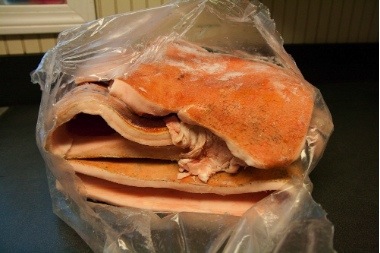Lard has been much maligned recently, but I think with the "Trans Fat" scare, people are starting to realize that animal fats aren't really all that bad. On a scale between Good and Evil, lard is not exactly lily-white Luke Skywalker. It's more of the Han Solo type (after all, Han did shoot Greedo first). You can't help but love it and nibble it all over. Lard, that is. Not Han. Ok, well maybe Han a little.
Anyway, lard contains about 40% saturated fat and 45% monosaturated fat. For reference, coconut and palm kernal oil run 80% in saturated fat. It is also high in Omega 6 fatty acids, Vitamin D and has some nice anti-bacterial properties as well. There's a reason soap has traditionally been made from animal fats and don't even think about hanging that nice slab of beef for three weeks unless there is a nice layer of fat covering it.
But don't run out and buy a tub o' lard for your next cookoff. The lard from the store has been hydrogenated to increase shelf life. And like most things done for preservation, injecting the lard with Hyrdrogen negates a lot of the good benefits, leaving the fact that it is just a bunch of fat. The best and healthiest way to use lard is to render it yourself from pig fat from a local farmer.
You knew I was going to say that, didn't you.
This year, we bought a whole pig from a local farmer. What that means is that we purchased a pig and even though the farmer raised the pig and delivered him to the butcher, he was technically our pig. We paid the farmer for the pig and the butcher for the processing and got the added benefit of being able to specify what we wanted back in little packages. Because we don't believe in wasting anything from an animal, we got it ALL back. So we received about 154 lbs of pig parts, including the head and trotters. About 120 lbs of that pork were prime cuts, ham, and bacon. Not a bad deal.
In case you are wondering, the head is great for jowl bacon and tamales and some amazing stock. Waste not, want not!
But today is all about the lard. As part of our pig, we received about 20 lbs of back fat and leaf fat. For lard aficionados, leaf fat, the fat from around the kidneys, is preferred because it can be rendered "purer" with less porky flavor. Another tip for less porky flavor is to not overcook it. If you heat the fat until the cracklins turn brown, it's too late and you get a more "savory" lard.
We cooked our lard via the "wet" method, where we poured the hot oil into water to allow the water to bring the stray proteins out. Then you reheat the water/oil mix until you stop hearing any sizzling. At that point, all the water has evaporated out, and the oil you pour off cools to a snow-white finish. Yum!
The cracklins can be saved to flavor meat soups and to feed to the chickens on cold days where lots of calories will help them stay warm.
 The bag of fat as delivered from the butcher
The bag of fat as delivered from the butcher
 The bag opened. Leaf fat is hiding under the first slab of back fat.
The bag opened. Leaf fat is hiding under the first slab of back fat.
 Back fat being cubed. The smaller the cubes, the more yield. Also, it's easiest to cut the fat when it is semi-frozen.
Back fat being cubed. The smaller the cubes, the more yield. Also, it's easiest to cut the fat when it is semi-frozen.
 A slab o' fat makes lots of cubes.
A slab o' fat makes lots of cubes.
 Two pans of fat ready to go. Leaf fat is on the left, back fat on the right.
Two pans of fat ready to go. Leaf fat is on the left, back fat on the right.
 Pouring the oil into a pot of water, filtering out the cracklins and solids.
Pouring the oil into a pot of water, filtering out the cracklins and solids.
 We cooled our lard with snow, the traditional method!!
We cooled our lard with snow, the traditional method!!
 The finished product. We used less than half our fat to make this much lard.
The finished product. We used less than half our fat to make this much lard.



7 comments:
Now what, pray tell, will you be making with all that lovely lard?
I'd love to find out what qualities home rendered lard lends to homemade soap!
Urrrrrrp.
I'm curious to know what you'll do with the lard too. I have never used lard to make anything in my life.
So...is that a ring of something darker on top of the lard? What is it? And, do you just scoop it off, or do you do something with that, too? How long will this keep? Do you freeze it?
Hey MD,
That ring of something darker is air, so no need to scoop it off. You can freeze it. As it cooled, it sealed the jars though so it should be as sanitary as canning. I am experimenting with keeping one jar in the pantry in the dark, the rest are refrigerated/frozen. Fats are sensitive to sunlight and will go rancid.
NIBBLING HAN A LOT!!!! >:) not just a little!!
leaf fat makes the most WONDERFUL pie crust and pastries:
Double Crust
2 1/2 C unbleached all purpose flour
8 Tbs. leaf fat
8 Tbs. Irish butter (salted)
1/2 tsp. Kosher salt
6-8 Tbs.very cold water
Mix, flatten into 2 disks and wrap in plastic wrap. Chill one hour. Roll out, fill and bake your pie!
Post a Comment